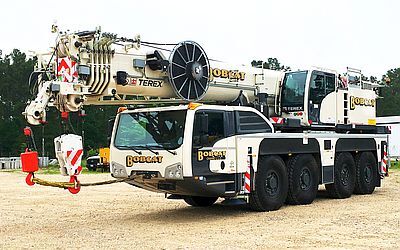
Jib cranes are an important part of modern industry, offering versatile lifting solutions across various sectors. Let’s explore types of jib cranes, their design, components, types, and environmental considerations when getting a jib crane from a crane rental company.
What is a Jib Crane?
A jib crane is a type of crane used in heavy industrial settings. It consists of a horizontal arm (jib or boom) attached to a fixed mast or wall, supporting a movable hoist. Jib cranes are known for their efficiency in lifting and moving loads within a fixed arc of rotation.
Components of a Jib Crane
Trolley
The trolley runs along the length of the jib or boom. It’s designed to carry the hoist and the load, allowing horizontal movement.
Reach/Boom
The reach or boom is the horizontal part of the crane. It dictates the crane’s reach and is crucial in determining the working area of the crane.
Movable Hoist
The hoist is attached to the trolley. It lifts and lowers the load using a wire rope or chain.
Mast/Pillar
The mast or pillar supports the boom. It can be freestanding, wall-mounted, or column-mounted, depending on the crane’s design.
Controls
Controls can be manual or automated, allowing the operator to manipulate the crane’s movements and hoist operations.
Electrification or Pneumatic Power
Jib cranes can be powered electrically or pneumatically. The choice depends on the requirements of the application and the environment in which the crane operates.
Rotation
Rotation refers to the crane’s ability to swing its boom horizontally. This feature is crucial for positioning the load precisely.
Hook Height
Hook height is the maximum height the crane’s hook can reach. It’s a critical factor for operations in facilities with height restrictions.
Rotation Stop
Rotation stops are mechanisms to limit the crane’s rotation. They protect everyone’s safety by preventing the crane from swinging into areas where it might cause damage or injury.
Environmental Considerations
Jib cranes must be designed considering the environment they’ll operate in. Factors like weather, temperature, and exposure to corrosive substances can affect the crane’s materials and design.
The Main Types of Jib Crane Systems and Factors in Selecting the Right Type of Jib Crane
Foundationless Jib Cranes
Foundationless jib cranes are designed for situations where a permanent foundation is not feasible. They are ideal for lighter loads and offer easy installation. These cranes can be relocated if needed, making them suitable for dynamic workspaces.
Freestanding Jib Cranes
Foundation/Insert Mounted
These cranes require a concrete foundation and are anchored using deep mounting inserts. They are robust, capable of handling heavy loads, and offer a wide range of motion.
Base-Plate Mounted
Base-plate mounted cranes are bolted to a concrete foundation using a large base plate. They provide high load capacities and are versatile in various industrial applications.
Sleeve-Insert Mounted
Similar to foundation/insert mounted, these cranes are fitted into a sleeve insert embedded in concrete. They are ideal for applications where the crane might need to be moved or removed.
Wall-Mounted Jib Cranes
Wall-mounted jib cranes are attached to structural walls or columns. They save floor space and are suitable for workstations where full 360-degree rotation is not required.
Mast-Type Jib Cranes
Mast-type jib cranes combine a freestanding design with a wall-mounted approach. They require a smaller foundation and are suitable for spaces where overhead clearance is limited.
Articulating Jib Cranes
Articulating jib cranes have two swivel arms, offering greater flexibility and precision. They can navigate around obstacles and are perfect for intricate material handling tasks.
Selecting the Right Jib Crane Type: Factors to Consider
Power Requirements
The power source, whether electric, hydraulic, or pneumatic, needs to align with the available utilities and the specific needs of the operation.
Height Under Boom
The height under the boom is important so that the crane fits into the workspace and can lift loads to the required heights.
Area of Rotation
The area of rotation determines the working range of the crane. It’s essential to consider the space limitations and the reach needed for operations.
Duty Cycle/Classification
The crane’s duty cycle relates to how often and intensely it will be used. Selecting a crane with the appropriate duty classification will guarantee longevity and safety.
Overall Jib Crane Height
The overall height of the crane must be taken into consideration, especially in facilities with ceiling constraints. It impacts the crane’s operational effectiveness.
The Required Working Span
This refers to the distance the crane must cover in its operations. A longer span can handle wider work areas, but it may require a stronger support structure.
Contact Bobcat Contracting to Get the Best Type of Jib Crane for Your Project with an Expert Crane Rental Company
For tailored crane solutions, Bobcat Contracting, a leading crane rental company, offers expertise in selecting and renting the right type of jib crane for your project. Our professionals can guide you through the selection process, making sure you get a crane that fits your specific needs and operational demands. Contact us to learn more and find the perfect crane for your project with an expert crane rental company.

